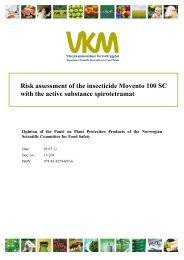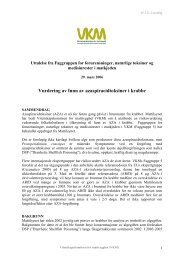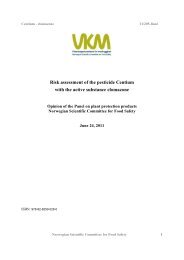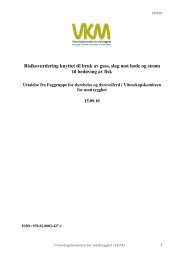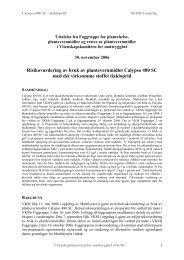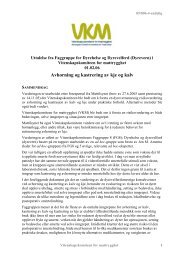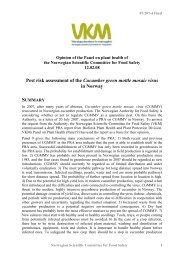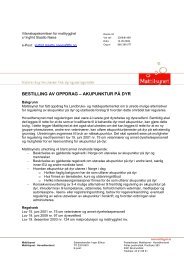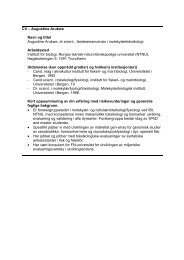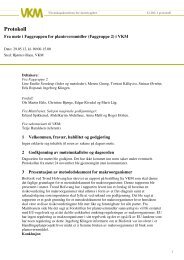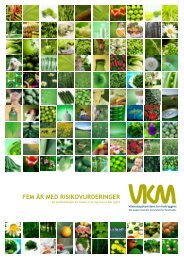Fiskevelferdsmessig vurdering av produksjon av 0-års smolt
Fiskevelferdsmessig vurdering av produksjon av 0-års smolt
Fiskevelferdsmessig vurdering av produksjon av 0-års smolt
Create successful ePaper yourself
Turn your PDF publications into a flip-book with our unique Google optimized e-Paper software.
following loss of homeostasis. Thirdly there is the loss of fin surface. This can impact<br />
negatively on the welfare of the inflicted individual, as it will experience reduction in<br />
the ability to master the cage environment. This is mainly a problem for 1+ <strong>smolt</strong>s<br />
as<br />
this is usually an effect of prolonged exposure to cool water. Upon transfer it is<br />
important to make sure that the fins are healed. Increased<br />
temperature and less<br />
biomass in the rearing tanks are efficient remedies.<br />
Water quality<br />
A complex of meteorological, geological and chemical systems interacting with, and<br />
reacting to, the biology of the fish. Suboptimal water quality reduces the ability of the<br />
fish to maintain homeostasis. The effects vary from minor deviations from normal<br />
physiology to immediate mortality. All deviation from optimal or near optimal water<br />
quality effects the <strong>smolt</strong> in the same way, that being 0+ or 1+ <strong>smolt</strong>s. The main<br />
difference is in how many times the <strong>smolt</strong>s are exposed to the suboptimal situation.<br />
Some of the problems are seasonal and will then affect one group to a larger extent<br />
than the other. The exposure to iron and aluminium is the main concern for the 0+<br />
<strong>smolt</strong>s <strong>smolt</strong>ifying in the fall. Other parameters such as CO2 can be more of a<br />
problem for 1+ <strong>smolt</strong>s as those are exposed for more episodes of low water flow<br />
(usually during peaks in biomass in the spring and fall). To <strong>av</strong>oid episodes caused<br />
be<br />
periods of deteriorating water quality continuous monitoring of water quality is<br />
recommended. In case of marginal or periodically<br />
marginal water quality one should<br />
consider to take steps to meet those problems.<br />
On transfer, 0+ <strong>smolt</strong> meet an environment with shortening days and falling<br />
temperatures, quite unlike the natural environment the 1+ <strong>smolt</strong>s experience. The 0+<br />
<strong>smolt</strong>s can meet the most extreme temperatures in the sea depending on place and<br />
time of transfer. Low temperatures make it difficult for the <strong>smolt</strong>s to adapt to the<br />
marine environment. There is an upper and lower limit for optimal transfer but those<br />
are not clearly defined. The recommendation is that one should not transfer <strong>smolt</strong>s<br />
at<br />
falling temperatures if the temperature is under 6-8° C. The 0+ <strong>smolt</strong>s are at a<br />
greater risk in terms of temperature as one can expect falling temperatures during fall<br />
transfer. It is important to ensure good <strong>smolt</strong> quality and the fish has the opportunity<br />
to adapt to the new environment prior to low temperatures. It is not recommended<br />
to<br />
transfer fish to low temperatures,<br />
and all handling must be careful as to <strong>av</strong>oid<br />
damage to mucus and skin.<br />
0+ <strong>smolt</strong>s are transferred into a light period that is quite different from the one 1+<br />
<strong>smolt</strong>s experience. It is common to transfer fish to natural light and introduce<br />
continuous light in early January, but is recommended that continuous light should be<br />
used for a fortnight in order to acclimate the fish to the new environment. This is an<br />
unique problem for 0+ <strong>smolt</strong>s as 1+ <strong>smolt</strong>s are transferred on increasing and natural<br />
light.<br />
Smolts are transported over long distances and during the transport one can meet<br />
with many problems. Due to restrictions or water quality on may be forced to run<br />
with<br />
closed well but, transport with closed wells should be for short time only or on<br />
vessels with sufficient recycling capacity to maintain acceptable water quality. When<br />
running with the well open to the sea one should be aware of brackish water zones<br />
that may inflict serious damage on the fish due to the water chemistry in such zones.<br />
13



